Chapter: Java The Complete Reference : The Java Library : java.util : The Collections Framework
The Collection Interfaces - java.util
The Collection Interfaces
The Collections Framework defines several core
interfaces. This section provides an overview of each interface. Beginning with
the collection interfaces is necessary because they determine the fundamental
nature of the collection classes. Put differently, the concrete classes simply
provide different implementations of the standard interfaces. The interfaces
that underpin collections are summarized in the following table:
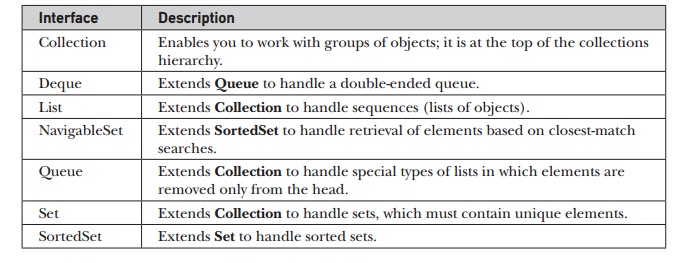
In addition to the collection
interfaces, collections also use the Comparator,
RandomAccess, Iterator, and ListIterator interfaces,
which are described in depth later in
this chapter. Beginning with JDK 8, Spliterator
can also be used. Briefly, Comparator
defines how two objects are compared; Iterator,
ListIterator, and Spliterator enumerate the objects
within a collection. By implementing RandomAccess,
a list indicates that it supports efficient, random access to its elements.
To provide the greatest
flexibility in their use, the collection interfaces allow some methods to be
optional. The optional methods enable you to modify the contents of a
collection. Collections that support these methods are called modifiable. Collections that do not
allow their contents to be changed are called unmodifiable. If an attempt is made to use one of these methods on
an unmodifiable collection, an UnsupportedOperationException
is thrown. All the built-in collections are modifiable.
The following sections
examine the collection interfaces.
The
Collection Interface
The Collection interface is the foundation upon which the Collections
Framework is built because it must be implemented by any class that defines a
collection. Collection is a generic
interface that has this declaration:
interface Collection<E>
Here, E
specifies the type of objects that the collection will hold. Collection extends the Iterable interface. This means that all
collections can be cycled through by use of the for-each style for loop. (Recall that only classes
that implement Iterable can be
cycled through by the for.)
Collection declares the core methods
that all collections will have. These methods are summarized in Table 18-1. Because all collections implement Collection, familiarity with its
methods is necessary for a clear understanding of the framework. Several of
these methods can throw an UnsupportedOperationException.
As explained, this occurs if a collection cannot be modified. A ClassCastException is generated when
one object is incompatible with another, such as when an attempt is made to add
an incompatible object to a collection. A NullPointerException
is thrown if an attempt is made to store a null
object and null elements are not
allowed in the collection. An IllegalArgumentException
is thrown if an invalid argument is used. An IllegalStateException is thrown if an attempt is made to add an
element to a fixed-length collection that is full.
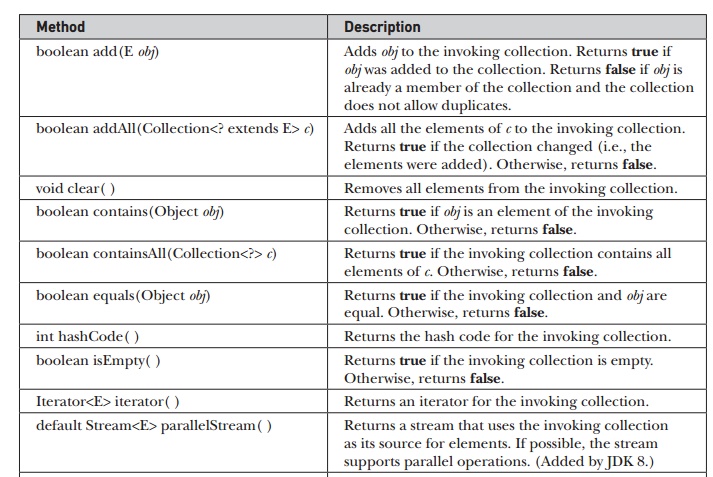

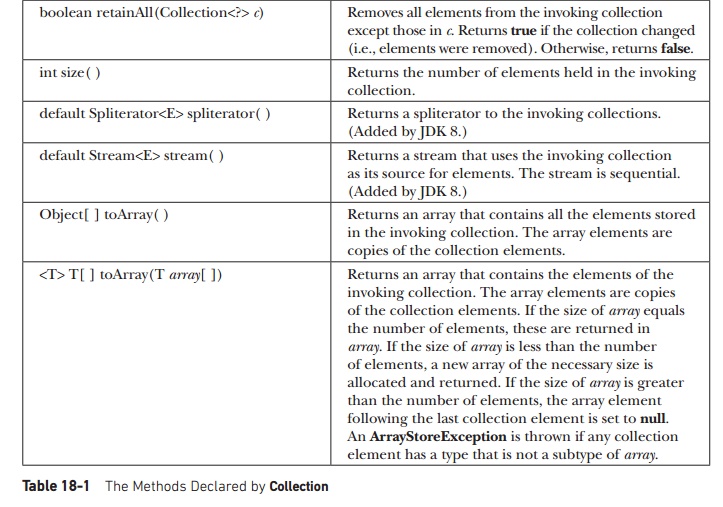
Objects are added to a
collection by calling add( ). Notice
that add( ) takes an argument of
type E, which means that objects
added to a collection must be compatible with the type of data expected by the
collection. You can add the entire contents of one collection to another by
calling addAll( ).
You can remove an object by
using remove( ). To remove a group
of objects, call removeAll( ). You
can remove all elements except those of a specified group by calling retainAll( ). Beginning with JDK 8, to
remove an element only if it statisfies some condition, you can use removeIf( ).
(Predicate is a functional interface
added by JDK 8. See Chapter 19.) To empty a collection, call clear( ).
You can determine whether a
collection contains a specific object by calling contains( ). To determine whether one collection contains all the
members of another, call containsAll( ).
You can determine when a collection is empty by calling isEmpty( ). The number of elements currently held in a collection
can be determined by calling size( ).
The toArray( ) methods return an array that contains the elements
stored in the invoking collection. The first returns an array of Object. The second returns an array of
elements that have the same type as the array specified as a parameter.
Normally, the second form is more convenient because it returns the desired
array type. These methods are more important than it might at first seem.
Often, processing the contents of a collection by using array-like syntax is
advantageous. By providing a pathway between collections and arrays, you can
have the best of both worlds.
Two collections can be
compared for equality by calling equals(
). The precise meaning of “equality” may differ from collection to
collection. For example, you can implement equals(
) so that it compares the values of elements stored in the collection.
Alternatively, equals( ) can compare
references to those elements.
Another important method is iterator( ), which returns an iterator
to a collection. The new spliterator( )
method returns a spliterator to the collection. Iterators are frequently used
when working with collections. Finally, the stream( ) and parallelStream(
) methods return a Stream that
uses the collection as a source of elements. (See Chapter 29 for a detailed
discussion of the new Stream
interface.)
The
List Interface
The List interface extends Collection
and declares the behavior of a collection that stores a sequence of elements.
Elements can be inserted or accessed by their position in the list, using a
zero-based index. A list may contain duplicate elements. List is a generic interface that has this declaration:
interface List<E>
Here, E specifies the type of objects that the list will hold.
In addition to the methods
defined by Collection, List defines some of its own, which are
summarized in Table 18-2. Note again that several of these methods will throw
an
UnsupportedOperationException if the list cannot be modified, and a ClassCastException is generated when
one object is incompatible with another, such as when an attempt is made to add
an incompatible object to a list. Also, several methods will throw an
IndexOutOfBoundsException if an invalid index is used. A NullPointerException is thrown if an attempt is made to store
a null object and null elements are not allowed in the
list. An IllegalArgumentException is
thrown if an invalid argument is used.
To the versions of add( ) and addAll( ) defined by Collection,
List adds the methods add(int, E) and addAll(int, Collection). These methods insert elements at the
specified index. Also, the semantics
of add(E) and addAll(Collection) defined by Collection
are changed by List so that they add
elements to the end of the list. You can modify each element in the collection
by using replaceAll( ). (UnaryOperator is a functional interface
added by JDK 8. See Chapter 19.)
To obtain the object stored
at a specific location, call get( )
with the index of the object. To assign a value to an element in the list, call
set( ), specifying the index of the
object to be changed. To find the index of an object, use indexOf( ) or lastIndexOf( ).
You can obtain a sublist of a
list by calling subList( ),
specifying the beginning and ending indexes of the sublist. As you can imagine,
subList( ) makes list processing
quite convenient. One way to sort a list is with the sort( ) method defined by List.
The Set Interface
The Set
interface defines a set. It extends Collection
and specifies the behavior of a collection that does not allow duplicate
elements. Therefore, the add( )
method returns
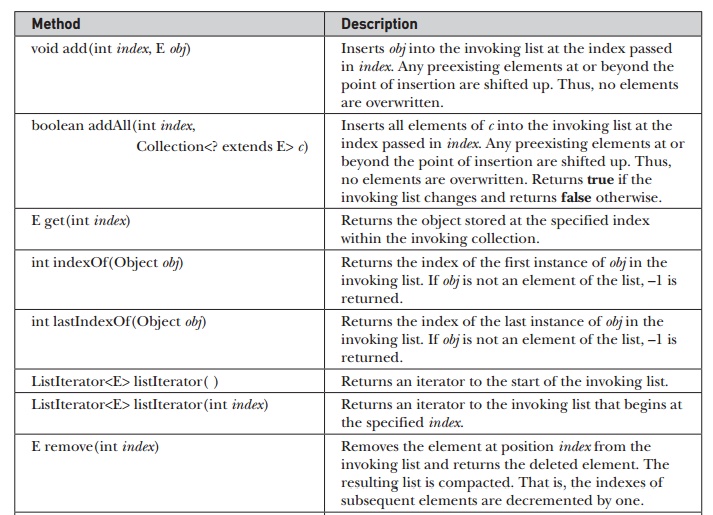
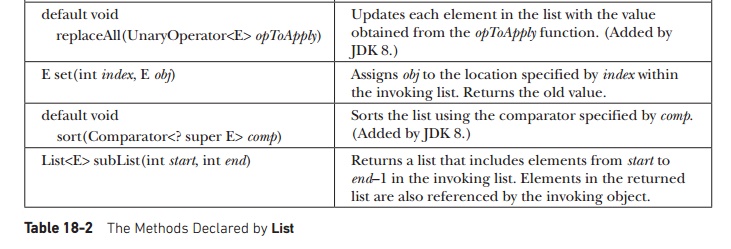
false if an attempt is made to add duplicate elements to a set. It does
not specify any additional methods
of its own. Set is a generic
interface that has this declaration:
interface Set<E>
Here, E specifies the type of objects that the set will hold.
The
SortedSet Interface
The SortedSet interface extends Set
and declares the behavior of a set sorted in ascending order. SortedSet is a generic interface that
has this declaration:
interface SortedSet<E>
Here, E specifies the type of objects that the set will hold.
In addition to those methods
provided by Set, the SortedSet interface declares the
methods summarized in Table 18-3. Several methods throw a NoSuchElementException when no items are contained in the invoking
set. A ClassCastException is thrown
when an object is
incompatible with the elements in a set. A NullPointerException
is thrown if an attempt is made to use a null
object and null is not allowed in
the set. An IllegalArgumentException is
thrown if an invalid argument is used.
SortedSet defines several methods that
make set processing more convenient. To obtain the first object in the set, call first( ). To get the last element, use last( ). You can obtain a subset of a sorted set by calling subSet( ), specifying the first and
last object in the set. If you need the subset that starts with the first
element in the set, use headSet( ).
If you want the subset that ends the set, use tailSet( ).
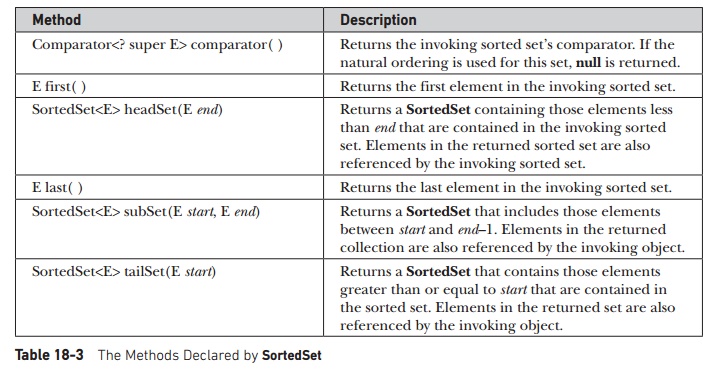
The
NavigableSet Interface
The NavigableSet interface extends SortedSet
and declares the behavior of a collection that supports the retrieval of
elements based on the closest match to a given value or values. NavigableSet is a generic interface
that has this declaration:
interface NavigableSet<E>
Here, E
specifies the type of objects that the set will hold. In addition to the
methods that it inherits from SortedSet,
NavigableSet adds those summarized
in Table 18-4. A
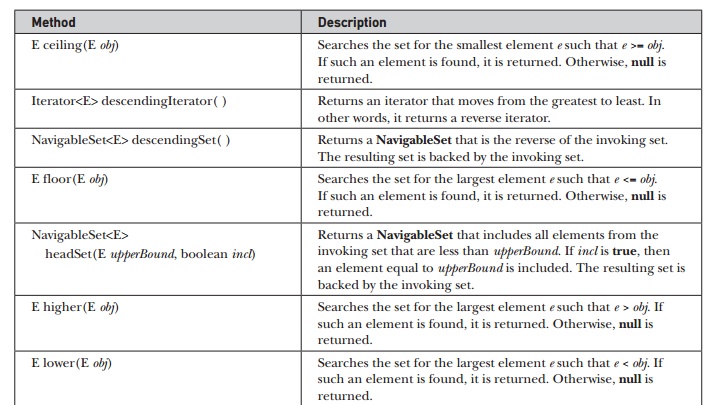
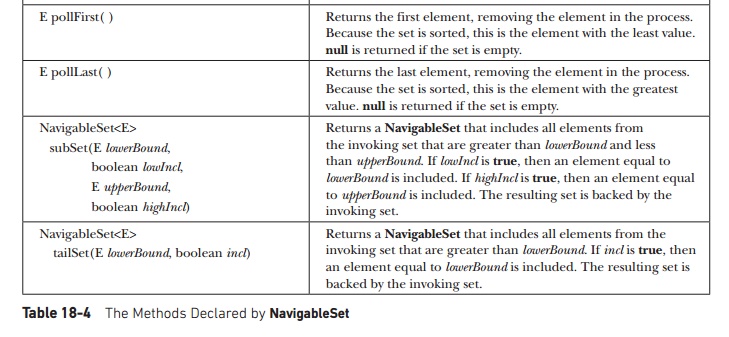
ClassCastException is thrown when an object is incompatible with
the elements in the set. A NullPointerException is thrown if an
attempt is made to use a null object
and null is not allowed in the set.
An IllegalArgumentException is
thrown if an invalid argument is used.
The
Queue Interface
The Queue interface extends Collection
and declares the behavior of a queue, which is often a first-in, first-out
list. However, there are types of queues in which the ordering is based upon
other criteria. Queue is a generic
interface that has this declaration:
interface Queue<E>
Here, E specifies the type of objects that the queue will hold. The
methods declared by Queue are shown
in Table 18-5.
Several methods throw a ClassCastException when an object is
incompatible with the elements in the queue. A NullPointerException is thrown if an attempt is made to store a null object and null elements are not allowed in the queue. An IllegalArgumentException is
thrown if an invalid argument is used. An IllegalStateException is thrown if an attempt is made to add an
element to a fixed-length queue that is full. A NoSuchElementException is thrown if an attempt is made to remove an
element from an empty queue.
Despite its simplicity, Queue offers several points of interest. First, elements can only
be removed from the head of the queue. Second, there are two methods that
obtain and remove elements: poll( )
and remove( ). The difference
between them is that poll( ) returns
null if the queue is empty, but remove( ) throws an exception. Third,
there are two methods, element( ) and peek( ), that obtain but don’t remove
the element at the head of the queue. They
differ only in that element( )
throws an exception if the queue is empty, but peek( ) returns null.
Finally, notice that offer( ) only
attempts to add an element to a queue. Because some queues have a fixed length
and might be full, offer( ) can
fail.
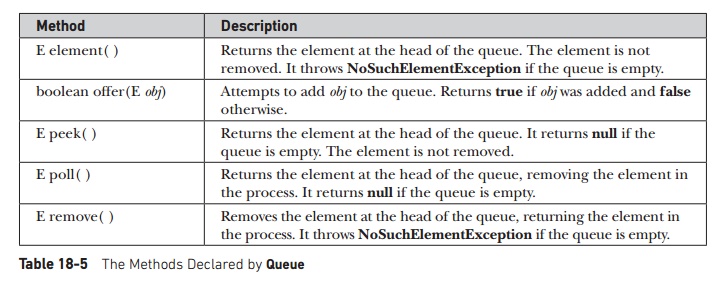
The
Deque Interface
The Deque interface extends Queue
and declares the behavior of a double-ended queue. Double-ended queues can
function as standard, first-in, first-out queues or as last-in, first-out
stacks. Deque is a generic interface
that has this declaration:
interface Deque<E>
Here, E
specifies the type of objects that the deque will hold. In addition to the
methods that it inherits from Queue,
Deque adds those methods summarized
in Table 18-6. Several
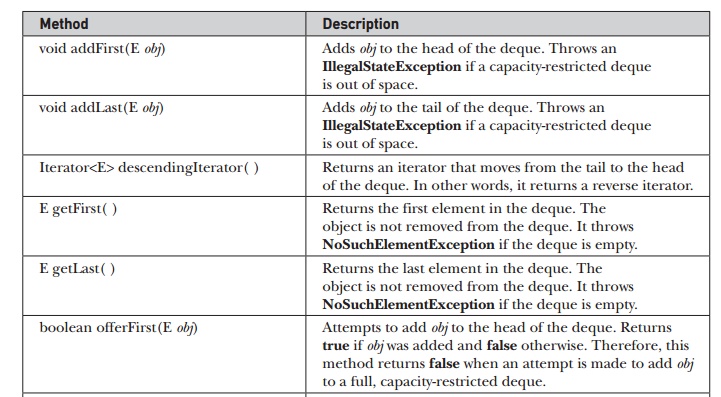
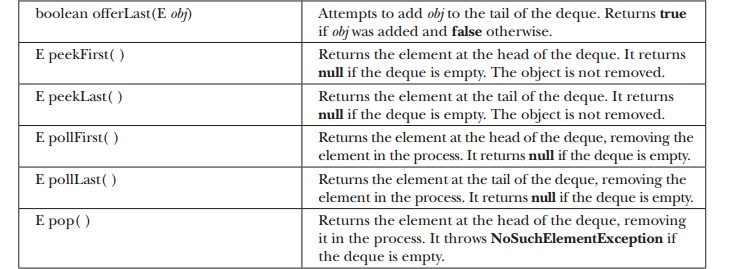
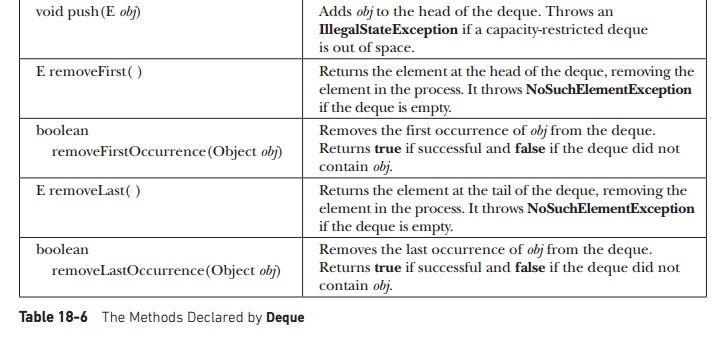
methods throw a ClassCastException when an object is
incompatible with the elements in the deque. A NullPointerException is thrown if an attempt is made to store a null object and null elements are not allowed in the deque. An IllegalArgumentException is thrown if an invalid argument is used. An IllegalStateException
is thrown if an attempt is made to add an element to a fixed-length deque that
is full. A NoSuchElementException is
thrown
if an attempt is made to
remove an element from an empty deque.
Notice that Deque includes the methods push( ) and pop( ). These methods enable a Deque
to function as a stack. Also, notice the descendingIterator( ) method. It returns an iterator that returns elements in reverse order. In other words,
it returns an iterator that moves from the end of the collection to the start.
A Deque implementation can be capacity-restricted, which means that
only a limited number of elements can be added to the deque. When this is the case, an attempt to
add an element to the deque can fail. Deque
allows you to handle such a failure in two ways. First, methods such as addFirst( ) and addLast( ) throw an IllegalStateException
if a capacity-restricted deque is full. Second, methods such as offerFirst( ) and offerLast( ) return false if
the element cannot be added.
Related Topics